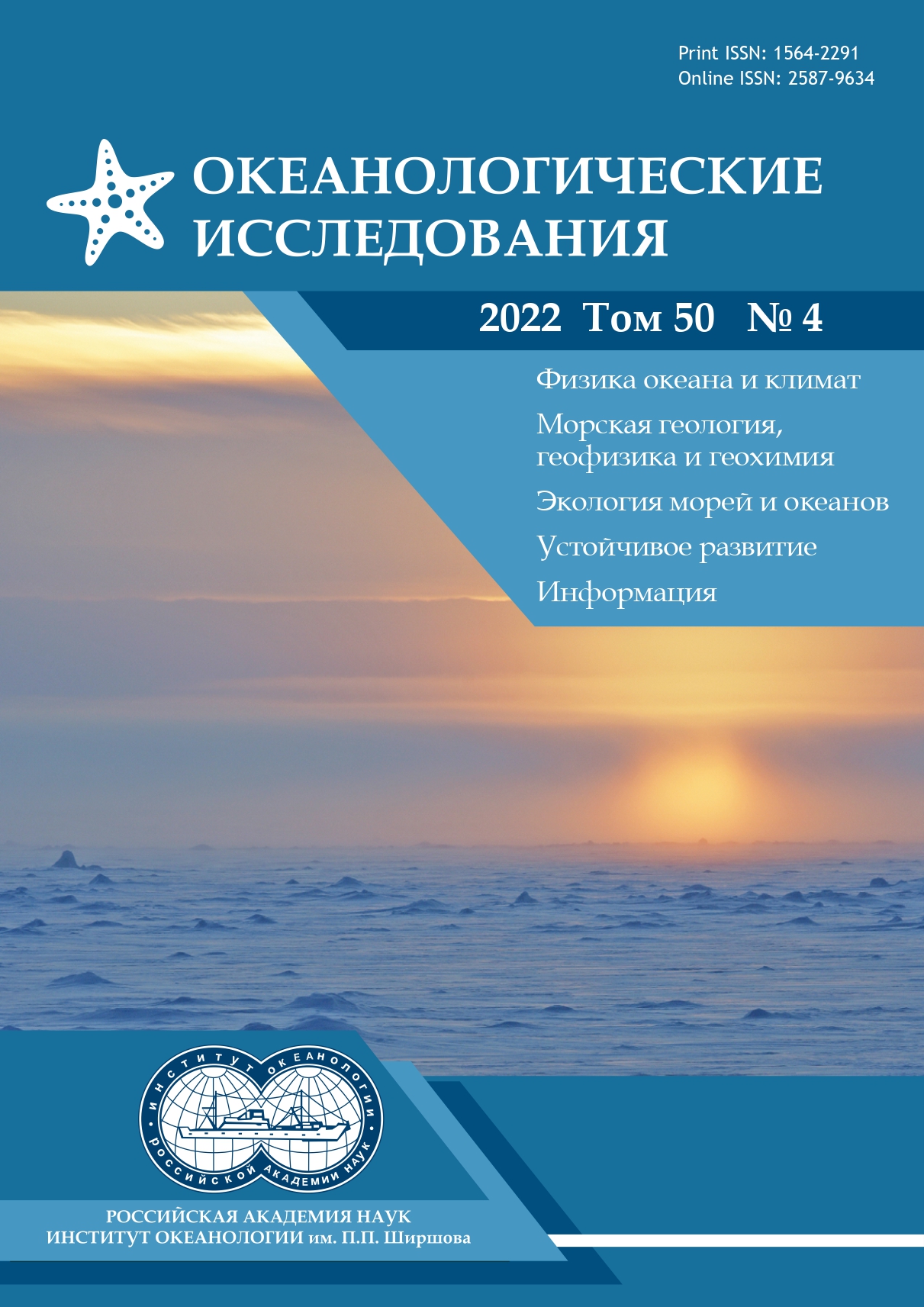ПРОДОЛЖИТЕЛЬНЫЕ ПОВЫШЕНИЯ И ПОНИЖЕНИЯ УРОВНЯ ПОКРЫТОГО ЛЬДОМ МОРЯ У ПОБЕРЕЖЬЯ ОХОТСКОГО МОРЯ В ЗАЛИВЕ МОРДВИНОВА
Аннотация
В статье приводится анализ причин повышения и понижения уровня моря подо льдом с использованием временных рядов колебаний уровня моря, полученных в результате измерений, проведенных в прибрежной зоне юго-восточного побережья о. Сахалин в 2019–2021 годах. Анализ всех событий повышения и понижения уровня моря показал, что они не связаны с приливными волнами, минимумы уровня моря соответствуют разным фазам прилива и длительность событий в несколько раз больше периода суточной приливной волны. Анализ причин обнаруженных шести событий понижения уровня моря свидетельствует о том, что они являются следствием продолжительных ветров западного направления, при которых ледяное поле припая отрывается от берега и на образовавшейся полынье под действием тех же ветров западного направления наблюдается сгон небольшой величины, который и регистрируется приборами как понижение уровня моря. Анализ выбранных семи событий, связанных с повышением уровня моря, показал, что обнаруживается их связь с понижением атмосферного давления при прохождении циклонов вблизи района наблюдений. Проведенное сравнение характера поведения уровня моря и коэффициентов регрессии для моря, покрытого льдом, с аналогичными для моря свободного от льда, показало, что для моря, свободного от льда, подъемы уровня по времени примерно в два раза продолжительнее и наступают позже минимумов атмосферного давления, по сравнению с достоверно установленными событиями для моря, покрытого льдом. При этом абсолютные величины коэффициента регрессии для моря, свободного от льда, в среднем почти в четыре раза меньше, чем для покрытого льдом. Выполнена проверка предположения о том, что континентальные шельфовые волны могут подпитываться колебаниями атмосферного давления с использованием модели шельфовых волн Бухвальда и Адамса. Полученные периоды шельфовых волн 37.7 часа из рассчитанных спектров подтвердили возможность передачи энергии в подъем уровня моря, а сами шельфовые волны могут подпитываться колебаниями атмосферного давления от проходящих циклонов.
Литература
- Герман В. Х. Об исследовании связи колебаний уровня моря с полем атмосферного давления как линейной динамической системы с постоянными параметрами // Труды Гос. Океаногр. института. 1974. Вып. 121. С. 13–21.
- Като Л. Н., Любицкий Ю. В., Шевченко Г. В. Оценка экстремальных значений сгонно-нагонных колебаний уровня моря на юго-восточном побережье о. Сахалин // Колебания уровня в морях: сб. ст. / Российский государственный гидрометеорологический университет. СПб., 2003. C. 111–128.
- Ковалев Д. П. Экстремальный сгон у юго-восточного побережья о. Сахалин // Фундаментальная и прикладная гидрофизика. 2013. Т. 6. № 1. С. 52–56.
- Ковалев Д. П. Kyma: программа для ЭВМ. RU 2018618773. № 2018612587; заявл. 20.03.2018; опубл. 19.07.2018.
- Лаппо С. С. Среднемасштабные динамические процессы океана, возбуждаемые атмосферой. М.: Наука, 1979. 181 с.
- Праудмэн Дж. Динамическая океанография. М.: Иностранная литература, 1957. 418 с.
- Рабинович А. Б. Длинные гравитационные волны в океане: захват, резонанс, излучение. Л.: Гидрометеоиздат, 1993. 325 с.
- Управление судном и его техническая эксплуатация. 3-е изд., перераб. и доп. / Под ред. А. И. Щетининой. М.: Транспорт, 1983. 656 с.
- Andrade M. M., Toldo E. E., Nunes J. C. R. Tidal and subtidal oscillations in a shallow water system in southern Brazil // Brazilian Journal of Oceanography. 2018. No. 66. P. 245–254. https://doi.org/10.1590/s1679-87592018017406603.
- Buchwald V. T., Adams J. K. The propagation of continental shelf waves // Proc. Roy. Soc. Ser. A. 1968. Vol. 305. P. 235–250.
- Cartwight D. E. Extraordinary tidal currents near St. Kilda // Nature. 1969. Vol. 223. P. 928–932.
- Cutchin D. L., Smith R. L. Continental shelf waves: low frequency variations in sea leve1 and currents over Oregon continental she1f // J. Phys. Oceanogr. 1973. Vol. 3. No. 3. P. 73–82.
- EOSDIS Worldview (nasa.gov). https://worldview.earthdata.nasa.gov.
- Gill A. E. Atmosphere-Ocean Dynamics. International Geophysics Series. Vol. 30. London: Academic Press, 1982. 662 p.
- Groves J. W., Zetler B. D. The Cross Spectrum of Sea Level at San Francisco and Honolulu // Journal of Marine Research. 1964. Vol. 22. P. 269–275.
- Hamon B. V. Continental shelf waves and the effects of atmospheric pressure and wind stress on sea level // J. Geophys. Res. 1966. 71. No. 12. P. 2883–2893.
- Japan Meteorological Agency. www.jma.go.jp.
- LeBlond P. H., Mysak L. A. Waves in the Ocean. Elsevier, 1978. 602 p.
- LeBlond P. H., Mysak L. A. Waves in the Ocean. Elsevier Oceanography Series. Vol. 20. Amsterdam: Elsevier, 1981. 602 p.
- Lopez M., Iglesias G., Kobayashi N. Long period oscillations and tidal level in the Port of Ferrol // Applied Ocean Research. 2012. Vol. 38. P. 126–134. https://doi.org/10.1016/j.apor.2012.07.006.
- Mysak L. Recent advances in shelfwave dynamics // Rev. Geophys. Space Phys. 1980. Vol. 18. P. 211–241.
- Robinson A. R. Continental shelf waves and the response of sea level to weather systems // J. Geophys. Res. 1964. Vol. 69. P. 367–368.
- Rombakis S. Der Einfluss meteorologischer Faktoren auf die Topographie des physikalisches Meeresniveau // Z. Meteorol. 1948. No. 2. P. 300–305. https://www.uib.no/ka/50867/den-aller-kaldaste-havstraumen.
- Sylte G. U. Den aller kaldaste havstraumen // Universitet I Bergen. 2010. https://www.uib.no/ka/50867/den-aller-kaldaste-havstraume.
- Truccolo E. C., Franco D., Schettini C. A. F. The Low Frequency Sea Level Oscillations in the Northern Coast of Santa Catarina, Brazil // Journal of Coastal Research. 2006. Vol. 1. P. 547–552.
- Volkov D. L., Landerer F. W., Kirillov S. A. The genesis of sea level variability in the Barents Sea // Continental Shelf Research. 2013. Vol. 66. P. 92–104. https://doi.org/10.1016/j.csr.2013.07.007.467.
- Xiao K., Chen M., Wang Q., Wang X., Zhang W. Low-frequency sea level variability and impact of recent sea ice decline on the sea level trend in the Arctic Ocean from a high-resolution simulation // Ocean Dynamics. 2020. Vol. 70. P. 787–802. https://doi.org/10.1007/s10236-020-46901373-5.
Передача авторских прав происходит на основании лицензионного договора между Автором и Федеральным государственным бюджетным учреждением науки Институт океанологии им. П.П. Ширшова Российской академии наук (ИО РАН)













